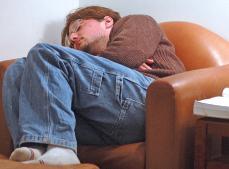It starts with a yawn.
Then your eyes droop, your head nods and your attention wavers to something far more inviting than a wooden desk — the unkempt bed at home, which has now been unoccupied for hours.
According to a Harvard study, these midday siestas are not just an instantaneous solution to weariness, they can also trim down the risk of heart-related death.
Harvard School of Public Health epidemiologist Dimitrios Trichopoulos found that, of the 23,681 Greek men and women who participated in the study, those who took 30-minute naps at least three times a week lowered his or her risk of cardiac death by 37 percent.
However, the collective nap of those toddler years has seemed to disappear, only to be replaced by day planners marked up, hour by hour, with obligations – a job interview at 10 a.m., a doctor’s appointment at 3:30 p.m.
As these responsibilities build – competing with each other, as in a race, to the top of the towering heap of straw piled onto the proverbial camel’s back – one’s natural instinct can be to nap, according to April Chester, a counselor at the counseling center.
“When people are burnt out – when they have too much stress and they’re just doing way too much – they use sleep as a way to slow down,” she said. “There needs to be a balance between restorative time and productive time.”
Restorative time, Chester said, involves taking a break from one’s obligations to do something refreshing. However, what fulfills this time differs from person to person.
“People who are more introverted tend to turn inward. They’ll read books or take walks,” she said. “Extroverts tend to stay around people to get their energy higher.”
But as the scale leans further toward time spent doing work, Chester said students could become siphoned of energy.
“When you feel the urge to nap, your body’s saying you need to sleep. There are health benefits to sleeping, and people tend to sleep more when they’re stressed,” she said. “Stress wears the body down, and it weakens the immune system.”
And contrary to the daily two-to-three-hour lunch breaks incorporated into the lives of many citizens of countries such as Italy and Spain, many post-college American lifestyles leave no time to take a quick rest during the afternoon. Most of the seven to eight hours of required sleep, according to Marianne Turnbull, director of Health Promotions, should come from REM sleep during the night.
Yet to restore the energy used to keep up with day-to-day activities, Chester recommends taking a 30-minute break from one’s workload to nap. Though the body is not physically productive during this rest, she said, the mind is using the time to revitalize itself.
“If you’re studying and you take a quick nap, it helps memory. When you’re sleeping during the night, you’re processing what you’ve learned during the day,” she said. “Not enough sleep impairs the memory, so if you’re learning a lot of information, you might just need to take a break and come back to it.”
But sometimes students will take naps only with the intent to evade work, Chester said.
“Some people nap to avoid doing things,” she said. “You could be a little tired and not want to do your work. It seems easier just to crawl in bed to try to avoid things.”
And it’s not just why one naps, but how, that matters. Interrupting a nap that hasn’t lasted the entire sleep cycle, Chester said, can be detrimental to both energy and concentration.
According to Chester, upon waking from a nap that has surpassed stages one through four (stages one and two consist of a light sleep, while stages three and four are characterized by slower breathing and heart rates) and has delved into REM sleep, one can feel both groggy and disoriented. Napping into the fifth stage disturbs the daily sleep cycle, which can cause both difficulties falling asleep and a restless night.
Though taking short siestas could sustain the heart’s strength, Chester said they shouldn’t be used to make up for a lack of sustainable rest during the night.
“Naps don’t necessarily fix the problem. If it’s a recurring thing – you’re taking a nap every day – and it’s not helping you, you need to take a look at your obligations and schedules,” she said. “There’s an issue there that needs to be resolved.”
Siestas and sleeping:
Long naps don’t just displace time. When recurring, or when used as a method to escape commitments, naps may indicate depression.
“Fatigue and the urge to sleep can be a sign of depression. It’s a symptom in a cluster of symptoms that would indicate depression.”
Other symptoms she listed included lack of motivation, a generally depressed mood, withdrawal from people, not feeling like getting out of bed at all and the inability to concentrate.
Source: April Chester, counselor, counseling center
Interrupting the sleep cycle is what makes you groggy, not going into deeper stages of sleep.
Studies show taking a 20-minute nap in the afternoon provides more rest than hitting the snooze button for the same amount of time in the morning.
Though some experts advise taking naps that last between 15 to 30 minutes, others suggest a one-hour nap has more restorative effects, including an improvement in cognitive function.
About eight hours upon waking, the body begins to slow down and become more tired.
Deep sleep is believed to be the stage during which the body repairs itself, while REM sleep is the stage during which the mind repairs itself.
Source: www.stress.about.com








